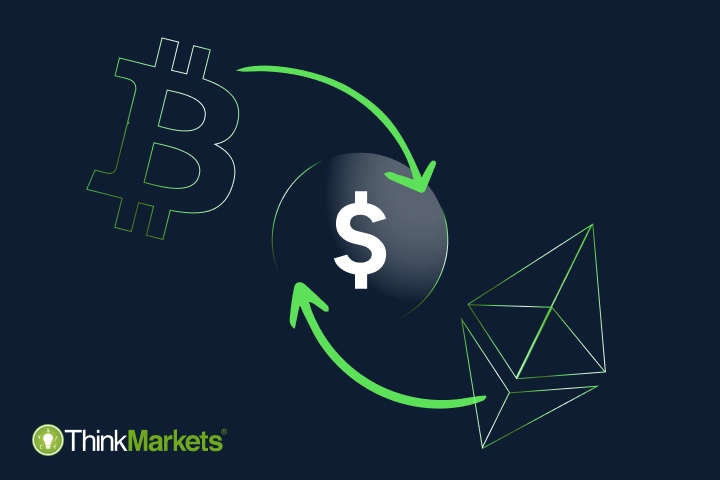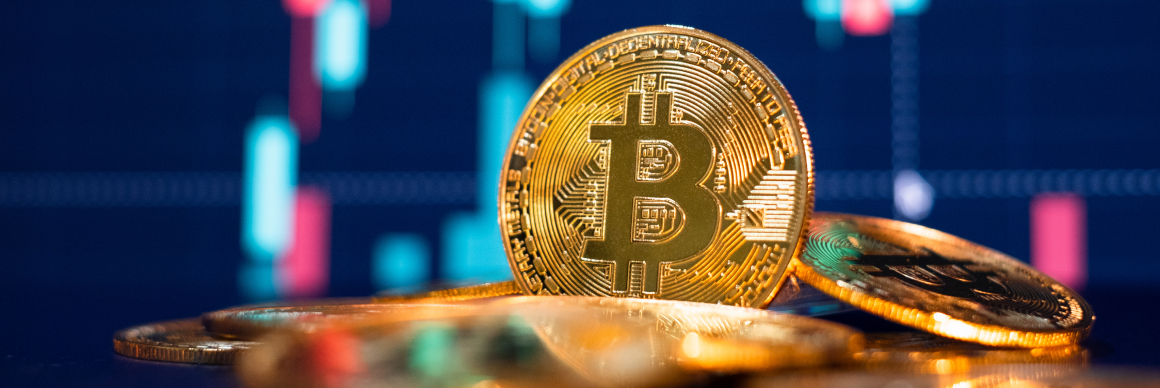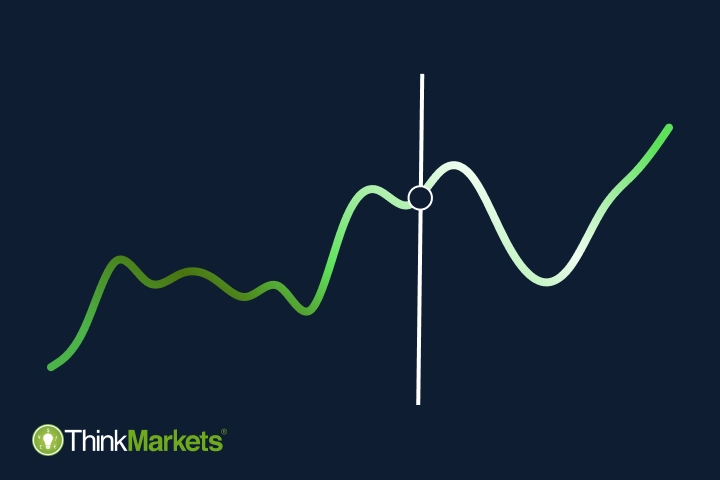Crypto Trading Articles
Improve your cryptocurrency knowledge by learning the basics of what they are and how you can trade them.

Articles (5)

How to trade crypto
<p>Crypto trading is surrounded by a lot of myths that scare away many people. Some think it’s expensive; others are concerned about its unpredictability. Quite often, these myths stem from a lack of understanding of cryptocurrency’s nature. After all, the cryptocurrency market is different from other financial markets. For one, cryptocurrencies have no physical form, so they can't change hands like gold or foreign currencies.<br /> <br /> In this article, we’ll explain the difference between crypto trading and investing and focus on one of the most popular ways to trade crypto – CFD trading. If you need to brush up on the basics of crypto, you can check out our <a href="/en/trading-academy/crypto/what-is-cryptocurrency">What is cryptocurrency, and how does crypto work</a> article before diving into cryptocurrency trading.</p> <h2>Crypto trading vs crypto investing</h2> <p> When looking to gain access to the crypto market, there are three possible scenarios to choose from: <br /> </p> <p>1. Buy and hold for an extended period of time to profit from the price increase.<br /> <br /> 2. Buy and sell regularly to profit from small price increases – crypto day trading.<br /> <br /> 3. Trade on the price movements with derivatives like CFDs.<br /> </p> <p paraeid="{4ae88016-a75c-44a6-af82-0cf7723ac87b}{215}" paraid="2140074582">Whenever buying the asset outright, as is the case with option 1, that's know as investing, and it can require substantial investment to make a considerable profit. It’s a strategy that has worked well for many when Bitcoin’s price was steadily climbing. However, investors are also the first to take the hit when crypto prices drop. <br /> </p> <p paraeid="{d7a63124-0b4c-4d34-80ee-1a17bba0613f}{28}" paraid="1728185531">The second and third options – trading cryptocurrency with CFDs, requires a much smaller amount of capital to start and can be beneficial even during crypto crashes. Moreover, CFD traders don't need to worry about having a crypto wallet or guarding their private key – they only need a trading account with an online broker.</p> <p><br /> <br /> <img alt="" src="/getmedia/40c7c01b-71b7-4c56-b2c9-c5fff357b984/article-how-to-trade-crypto-trading-vs-investing.webp" /></p> <h2>How to trade crypto with CFDs</h2> <p>Contracts for difference, or CFDs, are one of the most popular forms of derivative trading – allowing you to speculate on price movements without owning the underlying asset. If you are not familiar with derivative trading, check out our <a href="/en/trading-academy/cfds/what-are-cfds">CFD trading: a beginner’s guide</a><a href="/en/trading-academy/cfds/what-are-cfds"> </a>where we explain it in detail.</p> <p paraeid="{d7a63124-0b4c-4d34-80ee-1a17bba0613f}{120}" paraid="428144058">Many traders open and close contracts within the same day to avoid trading fees for holding a contract open overnight. However, although CFDs do incur overnight fees, they do not expire and can be used for a long-term strategy. </p> <p paraeid="{d7a63124-0b4c-4d34-80ee-1a17bba0613f}{164}" paraid="2122396469">When you trade on a cryptocurrency or any other financial market with CFDs, you can open two types of positions: long or short. </p> <h3>Going long</h3> <p>Traders open long (buy) positions when their research indicates that the price will increase. Let's say you decide to trade on Bitcoin. The current price is USD 22,500. You open a long position, and the price goes up to USD 22,600. The difference – USD 100 – is your profit. If the price drops to 22,400 instead, the USD 100 would become your loss.<br /> <br /> <img alt="" src="/getmedia/86eb405f-c7a7-4f80-91ba-8afdd17618ed/article-how-to-trade-crypto-long.webp" /></p> <h3>Going short</h3> <p>In a reverse scenario, when traders anticipate the price to drop, they open short (sell) positions. Let's say your research says that Bitcoin will depreciate soon, and you open a short position. Since you don't own any Bitcoin when you trade CFDs, you are not actually selling it; it's just that – opening a sell contract.<br /> <br /> If the price drops to USD 22,400, the USD 100 difference is your profit. However, if your research was incorrect and the price goes up to USD 22,600 instead, the USD 100 becomes your loss.<br /> <br /> <img alt="" src="/getmedia/948368c3-9740-4b83-a7f1-f687a12f1053/article-how-to-trade-crypto-short.webp" /><br /> <br /> To protect themselves from sudden unexpected price jumps, traders use risk management tools, such as stop loss and take profit. We explain how they work in our CFD trading guide, too.</p> <h2>What are the benefits of trading crypto with CFDs?</h2> <p>Crypto CFD trading is quickly gaining popularity for various reasons. Here are some of them:</p> <h3>Demo account</h3> <p>While you can't practice buying crypto, you can always create a demo account to test your CFD trading skills. Almost every trading platform nowadays offers free-of-charge and <a href="/en/demo-account">risk-free demo accounts</a> with functionality identical to real money accounts.</p> <h3>Leverage</h3> <p>CFD trading usually comes with leverage – borrowed funds from a broker to open larger positions. Depending on how big your leverage is, all you need to do is put down a small deposit, called a margin, to open a trade. If your trade is successful, your profit multiplies. However, in a losing trade, the loss multiplies too. That's why using risk management tools is crucial in every trading strategy.</p> <h3>Weekend trading</h3> <p>Since cryptocurrencies are not subject to following any centralised institutions, the crypto market is available for trading round the clock, even when the other markets are closed.</p> <h3>Trading on rising and falling markets</h3> <p>As you can see in our previous example, it doesn't matter whether the price goes up or down – for a CFD trader, both options are good. That's why when crypto owners hold their breath during yet another roller coaster ride their cryptocurrency experiences, CFD traders welcome both dips and rises with open arms.</p> <h3>Multiple trading opportunities</h3> <p>Those rollercoaster rides happen quite often – the market is relatively new and very volatile. When you trade crypto with CFDs, the more often the prices go up and down, and the bigger the swings are, the more trading opportunities it presents. However, rapid price movements can potentially result in losses too. That's why, as we mentioned previously, using <a href="/en/trading-academy/cfds/risk-management-tools-in-cfd-trading">risk management tools in CFD trading</a><a href="/en/trading-academy/cfds/risk-management-tools-in-cfd-trading"> </a>is extremely important.</p> <h2>Most popular cryptocurrencies to trade</h2> <p>The list of the most popular cryptocurrencies is very fluid, as some coins fall in and out of favour for one reason or another.<br /> <br /> Here are some of the most popular cryptocurrencies that are often mentioned in the top 5 and top 10 lists:<br /> </p> <ul> <li>Bitcoin (BTC)</li> <li>Ethereum (ETH)</li> <li>Binance coin (BNB)</li> <li>Ripple (XRP)</li> <li>Cardano (ADA)</li> <li>Dogecoin (DOGE)</li> </ul> <p><br /> Keep in mind that for CFD traders, the actual investment you make plays a less important role than for investors because CFD trades are leveraged. For example, with ThinkMarkets, you can trade Bitcoin CFDs with up to 50:1 leverage. This means that you only need to deposit 1/50th of its price to open a position.<br /> <br /> <img alt="" src="/getmedia/fcc0aad4-48bf-4bc0-bb8e-4ae92023bdb8/article-how-to-trade-crypto-capital.webp" /><br /> <br /> Moreover, if the required capital is larger than you are ready to allocate for a trade, you can always open smaller trades – as small as 0.01 of a full lot (which is one Bitcoin), and you'd need just a small amount for a deposit.<br /> <br /> Smaller trades usually work well for beginner traders, allowing them to practice using risk management tools without risking too much of their budget. Another alternative for beginners is to open a demo account and practice trading with virtual funds.<br /> <br /> Demo accounts can also be very useful for testing trading strategies. However, to build a good strategy, a trader first needs to understand what exactly drives the cryptocurrency prices up or down to avoid missing trading opportunities. Head to our <a href="/en/trading-academy/crypto/what-affects-crypto-prices">What affects crypto prices</a> article, to find out the main factors behind crypto volatility.</p>

How to trade crypto CFDs on the weekend
<p>The cryptocurrency market is known for its non-stop nature, allowing traders to trade 24/7.</p> <p>For those interested in trading crypto CFDs (Contracts for Difference) on weekends, the opportunities and risks can differ from regular crypto trading.</p> <p>This article explores how you can effectively trade crypto CFDs during the weekend and presents the benefits as well as the strategies you can use to maximise your potential.</p> <h2>What are crypto CFDs?</h2> <p>Crypto CFDs are financial instruments that allow you to speculate on the price movements of cryptocurrencies without needing to own them.</p> <p>When trading a CFD, you enter a contract with a broker to exchange the difference in the price of a cryptocurrency between when you open and close the position. This makes it possible to trade in both rising and falling markets.</p> <h2>Why trade crypto CFDs on weekends?</h2> <p>CFD trading on weekends offers several advantages and comes with risks unique to the weekend market.</p> <p>CFDs allow you to trade with <strong>leverage</strong>, meaning you can open larger positions with a smaller initial investment. This can lead to significant gains if the market moves in your favour, but it also increases the risk of losses.</p> <p>Trading CFDs on weekends offers <strong>flexibility</strong> to those with busy weekday schedules. It also allows traders to react to price movements that occur only during what would traditionally be “off-hours.”</p> <p>Weekends can bring <strong>higher volatility</strong> due to lower trading volumes and fewer market participants. This volatility can present trading opportunities for those who know how to manage their risks. CFD traders can gain from both rising and falling prices, which can be advantageous during unpredictable market movements.</p> <p>With CFDs, you can make gains from both bull (rising) and bear (falling) markets. This means there are more opportunities to gain from high volatility, regardless of whether prices are going up or down.</p> <p>Lastly, trading CFDs means you don’t need to own the underlying cryptocurrency you want to trade. This allows you to speculate on the price without issues such as storing cryptocurrencies, managing crypto wallets, or worrying about the security of your assets.</p> <h2>Where can you trade crypto CFDs on weekends?</h2> <p>Brokers like ThinkMarkets offer 24/7 access to crypto CFD trading, including weekends. For example, with ThinkMarkets you can trade various cryptocurrencies, such as Bitcoin and Ethereum, with leverage to take advantage of weekend price movements.</p> <p>Trading crypto CFDs is done through a trading platform. ThinkTrader is the ideal platform for crypto CFD trading with ThinkMarkets. It offers advanced charting tools, risk management features, and a streamlined, user-friendly interface for a smooth trading experience. Additionally, it allows you to automate your trading strategies, so you don’t have to constantly monitor the market.</p> <h2>Risks of trading crypto CFDs on weekends</h2> <p>During weekends, liquidity can be significantly lower because of fewer traders participating. This <strong>lower liquidity</strong> can lead to wider spreads, making it more costly to open and close positions. It also means that large trades can have a more significant impact on market prices, which can often lead to slippage.</p> <p>Trading with <strong>leverage</strong> magnifies both gains and losses. While leverage can increase potential returns, it can also increase the risk of significant losses. During weekends, trading with leverage requires careful risk management to avoid unwanted results.</p> <p><strong>Price gaps</strong> can occur more frequently over weekends, especially during low-volume hours. A price gap happens when the market price makes a significant move up or down without any trading in between. This can result in your stop-loss orders being executed at a worse price than expected.</p> <h2>Strategies for trading crypto CFDs on weekends</h2> <p><strong>Swing trading</strong> is a popular strategy for weekend trading. It involves holding a position for several hours or days to capture price swings. Swing trading allows you to take advantage of short-term price movements that occur during these periods. Using technical indicators like Bollinger Bands and Moving Averages can help you identify entry and exit points.</p> <p>If you already hold a crypto position, you can use CFDs for <strong>hedging</strong> against potential losses. For example, if you own Bitcoin and are concerned about a potential drop in its price over the weekend, you can open a short position to offset any losses. Hedging helps you protect your investments during periods of uncertainty.</p> <p><strong>Automated trading bots</strong> can be particularly useful for weekend CFD trading. Many platforms allow you to set up bots that execute trades based on predefined parameters. This is beneficial for managing the rapid price movements that can occur over the weekend. Automated bots can also help remove emotional bias from your trading decisions.</p> <p>Weekend trading often leads to the formation of price ranges. <strong>Range trading</strong> involves identifying support and resistance levels and trading within that range. This strategy can be effective if you notice that the price is bouncing between two levels. This allows you to buy at support and sell at resistance.</p> <h2>5 tips for successful weekend crypto CFD trading</h2> <h3>Use stop-loss and take-profit orders</h3> <p>These are tools to help you manage your risk. They will automatically close your positions once your preset profit or loss level is reached. Due to the unpredictability of the weekend market, setting these orders can help protect your capital.</p> <h3>Monitor key market news</h3> <p>Weekend markets can be heavily influenced by news events, such as regulatory announcements or unexpected developments in the crypto space. Staying informed by following crypto news sites and social media channels may help you react quicker to any major market-moving event.</p> <h3>Avoid overleveraging</h3> <p>Leverage can be tempting, especially during times of high volatility, but it is essential to use it wisely. Overleveraging can lead to larger losses if the market moves against you. Always use leverage with caution and consider reducing your position size during particularly volatile times.</p> <h3>Monitor spreads</h3> <p>As previously mentioned, spreads can widen over weekends. Therefore, make sure to check the spread before placing your trade. High spreads mean higher costs, so this is important to factor into your strategy.</p> <h3>Use technical analysis tools</h3> <p>Technical analysis tools like RSI (Relative Strength Index), MACD (Moving Average Convergence Divergence), and Fibonacci retracements can help you better identify rising opportunities. These tools are especially useful on weekends when fundamental analysis might be less effective due to fewer participants.</p>

What is the Bitcoin Halving Event?
<p>Bitcoin is arguably the most popular cryptocurrency in the world. News on this coin affects BTC’s price and sets forth a wave of price swings in other cryptocurrencies. That is why crypto traders are all waiting in baited anticipation for the Bitcoin Halving event.<br /> <br /> Occurring every 4 years, the Bitcoin Halving event is pivotal for Bitcoin’s network protocol and the entirety of the cryptocurrency market. In essence, the event reduces the reward given to Bitcoin miners for validating transactions on the blockchain. This reduction is hard coded into the Bitcoin protocol to ensure a predictable and controlled supply of BTC over time.<br /> <br /> The Bitcoin Halving, often called the heartbeat of the Bitcoin network, plays an important role in regulating the inflation rate of BTC. This controlled supply is what differentiates BTC from traditional fiat currencies, where central banks and governments can print more money should the need arise.<br /> <img alt="Picture1.png" src="/getmedia/e4681d7c-abe2-4766-97c5-ac66fcc6d1ae/Academy-Market-events-What-is-bitcoin-halving-event.webp" title="Picture1.png" /></p> <p>When Satoshi Nakamoto created BTC in 2009, he specified that the total supply of BTC would be capped at 21 million coins. To gradually introduce new Bitcoins into circulation and incentivise miners to secure the network, a reward system was implemented. Initially set at 50 bitcoins per block, this reward is halved approximately every four years, or after every 210,000 blocks mined.<br /> <br /> As a result, the issuance rate of new bitcoins decreases over time, leading to a gradual reduction in the rate of Bitcoin supply growth.</p> <h2>Impact of Bitcoin Halving Event</h2> <p>The scheduled Halving events have a direct impact on the Bitcoin supply. With each event, the number of new bitcoins that enter the market is effectively cut in half. This reduction mechanism adds value to Bitcoin as it is protected against inflation.<br /> <br /> Many investors use this coin as a hedge against inflation, citing its ability to preserve purchasing power over time. In addition to this, changes in the supply dynamics influence the price expectations and market sentiment, creating major price volatility leading up to and following each Halving event.<br /> <br /> The limited supply and scarcity of Bitcoin increases its investor appeal, bringing the price upwards.</p> <h2>Overview of Historical Bitcoin Halving Events</h2> <p>Since its inception, there have been three Bitcoin Halving events with the next scheduled around April 18-19, 2024:</p> <style type="text/css">table { border-collapse: collapse; width: 100%; } td, th { border: 1px solid #dddddd; text-align: left; padding: 8px; } tr:nth-child(even) { background-color: #dddddd; } </style> <table> <tbody> <tr> <th>Date</th> <th>Pre-halving reward</th> <th>Post-halving reward</th> </tr> <tr> <td>November 2012</td> <td>50 bitcoins</td> <td>5 bitcoins</td> </tr> <tr> <td>July 2016</td> <td>25 bitcoins</td> <td>12.5 bitcoins</td> </tr> <tr> <td>May 2020</td> <td>12.5 bitcoins</td> <td>6.25 bitcoins</td> </tr> <tr> <td>April 2024</td> <td>6.25 bitcoins</td> <td>3.125 bitcoins</td> </tr> </tbody> </table> <p>Check out our article on the previous Bitcoin Halving events and the impact on the price of BTC here.<br /> <br /> Trade the 2024 Bitcoin Halving event with ThinkMarkets now. Access 50:1 leverage, market-leading tight spreads, and 24/7 client support team. Portal.thinkmarkets.com</p>

What affects crypto prices?
<p>The cryptocurrency market is highly volatile. It was first established in 2009 with the invention of bitcoin, but the world has already witnessed quite a few large spikes and plunges of various digital currencies. It may be bad news for cryptocurrency investors, whose goal is to build up profit on increasing prices, but if you trade cryptocurrency with CFDs, it’s a land of potential opportunities.<br /> <br /> In this article, we’ll explore the main factors driving crypto prices up and down and examine the Bitcoin case study that made headlines at some point.</p> <h2>The main drivers of the cryptocurrency market</h2> <p>In terms of factors affecting price movements, the crypto market is no different than any other financial market as it depends on cryptocurrency supply and demand.</p> <p paraeid="{d4ca0ffb-e5c5-479c-95a6-5d91711657d0}{27}" paraid="319051773">In some cases, it's quite straightforward. For example, one of the reasons Bitcoin is so popular is that its circulating supply is limited to 21 million coins. This limit cannot be changed because it has been encoded into it upon its creation. It means that just like any other scarce asset with demand exceeding supply, Bitcoin is supposed to grow in value, and makes a volatile alternative to holding ever deprecating fiat currency. </p> <p paraeid="{d4ca0ffb-e5c5-479c-95a6-5d91711657d0}{57}" paraid="2052867750">However, when the first cryptocurrency dropped from an all-time high of nearly USD 70,000 to a little over USD 16,000 in just a year, it became clear that cryptocurrencies are still a very speculative asset class and demand for it is not as stable as that for gold, for example. <br /> <br /> Here are the main factors that play a role in the price formation of cryptocurrencies:<br /> <br /> <img alt="" src="/getmedia/7ba7c6f7-7451-470a-9a00-d76618203a86/what-affects-crypto-prices_1.png?width=550&height=295" /></p> <h3>Stock market</h3> <p>It may not seem intuitive, but when the stock market goes down, so does crypto. The explanation is quite simple – people steer clear of risky instruments like cryptocurrencies when there’s a market downturn and buy safe-haven instruments like gold, which drives crypto prices down.</p> <h3>Regulations</h3> <p>Any regulation that can be perceived as strengthening crypto's security and trust usually has an almost immediate positive effect on its prices. On the other hand, any negative news, such as new policies regulating cryptocurrency or crypto bans in some countries, brings its prices down.</p> <h3>Social media</h3> <p>The social media hype around some cryptocurrencies has proven to be very influential on their prices on multiple occasions. Elon Musk's tweets alone have caused quite a few upward and downward movements.</p> <h3>Security concerns and crypto collapses</h3> <p>Security breaches and the collapses of the cryptocurrency exchanges like FTX have a strong negative effect on the entire crypto market. Many people start panic selling their crypto assets, driving the prices down and creating a lot of trading opportunities for CFD traders who are looking to speculate on the price movements of cryptocurrencies.</p> <h2>How the drivers of cryptocurrency prices work</h2> <p>All the factors we've discussed above can be very influential on their own, but usually, it's a combination of several of them that causes significant moves. Let's see how it works using Bitcoin as an example.</p> <h3>How did Bitcoin reach the all-time high?</h3> <p>In a series of events in 2021, Bitcoin made headlines reaching an all-time high of nearly USD 70,000. Here is a timeline of events and factors that played a major role in it:<br /> <br /> <strong>March, 2021</strong><br /> As 2021 has been marked by the ongoing COVID-19 pandemic, the US government released the third and largest stimulus check to support the economy and reduce the financial strain on consumers and businesses. People pile into Bitcoin as a hedge against inflation, out of boredom, and as they can’t spend their money on holiday trips and clothes as usual.<br /> <br /> <strong>July, 2021</strong><br /> After some back-and-forth contemplation on his decision, Elon Musk announced that Tesla will likely start accepting payments in Bitcoin after all.<br /> <br /> <strong>September, 2021</strong><br /> El Salvador became the first country in the world to use Bitcoin as a legal tender, requiring all businesses to accept it as a form of payment.<br /> <br /> <strong>October, 2021</strong><br /> The first Bitcoin exchange-traded fund, ProShares Bitcoin Strategy ETF, was approved and launched in the US.<br /> <br /> <strong>November, 2021</strong><br /> Bitcoin developers released Taproot – the largest system upgrade in four years, designed to expand its functionality and decrease transaction fees.<br /> <br /> All in all, US traders were left with spare money in their hands and a lot of indicators suggesting Bitcoin’s positive outlook. As the capital invested in this promising crypto coin grew, attracting investors from other countries across the world, its price reached an impressive USD 67,566.83.</p> <h2>How did Bitcoin fall from its all-time high?</h2> <p>Inspired by its quick rise, some analytics predicted Bitcoin’s rally to continue. However, the end of 2021 brought a grim end to it. Here is the chronology of the main factors and events that influenced Bitcoin’s decline:<br /> <br /> <strong>November, 2021</strong><br /> Crippled by the pandemic, economies have reported the fastest inflation surge since 1982.<br /> <br /> <strong>December, 2021</strong><br /> The US intelligence released reports about Russia’s military offensive against Ukraine.<br /> <br /> <strong>January, 2022</strong><br /> Russia's central bank proposed to ban the use and mining of cryptocurrencies, following the example of eight other countries, including China, that have already imposed a full crypto ban.<br /> <br /> <strong>February, 2022</strong><br /> Russia launched a full-scale invasion of Ukraine, throwing global stock market into turmoil.<br /> <br /> <strong>March, 2022</strong><br /> Six months after El Salvador's Bitcoin adoption, reports revealed that cryptocurrency usage in the country remained very low, and the plan was likely to fail.<br /> <br /> <strong>Second quarter</strong><br /> Concerns about the high energy consumption required for Bitcoin mining and its negative environmental effects increased and intensified.<br /> <br /> <strong>End of the second quarter</strong><br /> Tesla sold 75% of its Bitcoin.<br /> <br /> As a result of these events, the world was left with a crashing stock market, a very pessimistic outlook on its future development and several indicators suggesting that crypto was not doing well. <br /> <br /> Cryptocurrency holders started turning towards safer investment options and selling their volatile and risky Bitcoin, driving its price down to a mark below USD 20,000.<br /> <br /> Today Bitcoin’s future remains unclear, with some analysts being very optimistic and some not expecting much. However, the number of trading opportunities these bull and bear runs presented for CFD traders is beyond imaginable.<br /> <br /> It's worth noting that most cryptocurrencies usually experience a domino effect, whether their prices rise or fall. Like stock indices belonging to the same industry, the price movements of different cryptocurrencies are often correlated. In the wake of Bitcoin's rise, many other digital coins also went up, and its crash caused their consecutive crash. That's why when looking for a trading opportunity on a certain cryptocurrency, it's worth checking a few others, as they may have potential too.</p> <h2>Market sentiment</h2> <p>All the main factors influencing cryptocurrency pricing have something in common – market sentiment. Digital coins are purely speculative and don't have an underlying asset to determine cryptocurrency values. For stocks, for example, it's a company's performance; for commodities, it's actual physical assets.<br /> <br /> That's why besides actual events influencing crypto prices, there is always an element of public perception of them. One good example of this influence is Dogecoin. Created as a sarcastic meme coin, this cryptocurrency gained over 600% in value, followed by a large drop, just because of the hype created by Elon Musk and other influential figures on social media.<br /> <br /> These are just a few examples that may explain what’s behind the highly volatile cryptocurrency market. Any hands-on trader can probably name a few more factors, but for new traders, it is not a bad idea to stick to basics at the beginning of their crypto journey. Practising your skills on a <a href="https://portal.thinkmarkets.com/account/individual/demo">demo account</a> can also help improve your knowledge.</p>

What is cryptocurrency, and how does it work?
<p paraeid="{4d1335ab-25a5-4f9b-bc5f-b52c5bd8b8d2}{203}" paraid="1031262227">Ever since Bitcoin was launched in 2009, "to buy or not to buy" has become almost as quintessential as "to be or not to be". Fast forward to today, where we have access to thousands of cryptocurrencies, and the question turns into "to buy or not to buy what exactly?". <br /> </p> <p paraeid="{4d1335ab-25a5-4f9b-bc5f-b52c5bd8b8d2}{217}" paraid="980772721">In this article, we'll go through the basics of crypto, exploring how they work and why they’re a popular form of currency. </p> <h2>What is crypto?</h2> <p>Cryptocurrency, or crypto, is a digital currency that has no physical form. Think of your regular bank account – quite often, you don't see the money coming in or out of it. You get your funds transferred to you electronically. When you use your bank card to pay for goods and services, the money gets deducted from your account and transferred to other establishments electronically as well. Crypto is exactly that – a currency that exists only in digital form.<br /> <br /> You cannot withdraw crypto from an ATM as you normally withdraw cash using your credit or debit card. That is to say, crypto ATMs exist too, but their functionality differs from cash ATMs. With a crypto ATM, you can exchange regular money, also called fiat, for cryptocurrency or vice versa. However, since crypto has no physical form, it cannot be withdrawn.<br /> <br /> The other significant difference between crypto and traditional currencies is decentralisation. Unlike fiat money, controlled by financial institutions and governments, most digital currencies are decentralised and not controlled by anyone. Moreover, there is also no centralised place to store crypto transactions – they are recorded on a public network of thousands of computers, called a blockchain.<br /> <br /> <img alt="" src="/getmedia/c95da2d2-2b02-40ac-b465-1b7818b3903d/article-what-is-crypto-table.webp" /></p> <h2>What is blockchain?</h2> <p>Imagine a company has a large book of accounts to keep a record of all their expenses, income and other documents to verify payments. Blockchain is pretty much like that – a digital ledger that keeps track of all cryptocurrency transactions that have ever happened. The difference is that this ledger is not kept within an accounting team – everyone in the crypto world can access it. However, if this ledger were an excel file, this public access would be limited to 'View only'. No one gets the 'Edit' access – not the accounting team, not even the CEO, to continue the company analogy. That's what makes crypto transactions so secure – the participants can access the public record and check its validity, but they cannot alter it to their own benefit.<br /> <br /> <img alt="" src="/getmedia/6148fbb6-b663-45d8-9018-60056a65fff3/article-what-is-crypto-blockchain.webp" /><br /> <br /> It may seem a little controversial – if everyone has access to everything, they can easily access sensitive data, too, right? Not quite. The reality couldn't be further from this. Let's see how it works.</p> <h2>Private and public key</h2> <p>Every person taking part in a crypto transaction has a set of two keys – a private and a public key. Both keys are unique combinations of numbers and letters that give access to certain functions.<br /> <br /> A private key is like a password to your online bank account – you don't want to share it with anyone because it gives access to all your funds. With crypto, a private key is the equivalent of a password to your crypto wallet. No one on the blockchain can access other participants' private keys, and it is crucial to keep them secure.<br /> </p> <p paraeid="{c99b8bfb-4ef6-44c4-bfc8-6cf20fc28ed3}{146}" paraid="2059569509">A public key is like a bank account number or, in this case, a digital wallet address where crypto assets are stored. It is public and can be accessed by anyone, just as you would share your bank account number so someone can transfer funds to it. Everyone can also see how much money the wallet contains. <br /> </p> <p paraeid="{c99b8bfb-4ef6-44c4-bfc8-6cf20fc28ed3}{166}" paraid="103957184">Every cryptocurrency transaction is secured through cryptographic techniques: the sender authorises the transaction with their private key, creating a digital signature. This signature, along with the transaction details, is verified on the network using the sender's public key but without disclosing the private key itself. Once confirmed and added to the blockchain, the funds are controlled by the recipient, who can then create new transactions with their own private key. </p> <p><br /> <img alt="" src="/getmedia/38bb8c28-d885-4058-9669-84015964bedf/article-what-is-crypto-keys.webp" /><br /> <br /> So, due to public key accessibility, everyone in the blockchain network can see when a transaction happens and that X amount of crypto has been moved from wallet A to wallet B. However, since no one can access the receiver's private key, they can only 'View' this transaction but not 'Edit' it.<br /> <br /> This process also plays an important role in cryptocurrency mining.</p> <h2>What is crypto mining?</h2> <p>All the transactions stored on a blockchain are grouped into blocks that are connected into a chain – that's where the name comes from. In a nutshell, mining means verifying these transactions, putting them together in blocks and adding these blocks to the blockchain.<br /> <br /> There are different types of blockchains and methods of transaction validation. Bitcoin blockchain, for example, uses a system that is called Proof-of-work. As Bitcoin is arguably the most popular virtual currency, and many other cryptocurrencies are mined the same way, we'll take Proof-of-Work as an example to explain how mining generally works.<br /> <br /> Whenever a new transaction gets signed off by a sender, it is distributed to the network. At this point, this transaction is still unconfirmed. A miner picks it up and checks whether it's authentic. Using a public key, miners can determine whether the transaction has been signed off by a sender and ensure that the sender owns the required amount of crypto.<br /> <br /> That's a simplified explanation. What actually happens in the background is complex mathematical equations that a miner needs to solve.<br /> <br /> <img alt="" src="/getmedia/0fad863e-a334-4cf2-9d26-0341c390e618/article-what-is-crypto-mining.webp" /><br /> <br /> Crypto mining requires advanced hardware and software. This, in turn, uses up a lot of energy. That's why hypothetically, anyone can become a crypto miner, but not everyone has the resources for it. However, the crypto mining industry is still very competitive due to its incentive – successful miners are rewarded with new coins. Bitcoin miners, for example, receive several Bitcoins every time they add a new block, so the reward makes the work worth it.<br /> <br /> If we compare the mining process with a company's book of accounts, a miner would be an accountant who checks all the transactions and adds a new page to the book.</p> <h2>Why is crypto secure?</h2> <p>As we already discussed, decentralisation and cryptography make cryptocurrencies very secure. The former provides transparency by keeping all the records public, while the latter protects sensitive information. In reality, cryptography plays a bigger role in protecting cryptocurrency.<br /> <br /> When a miner collects enough transactions to form a new block and solves a mathematical equation, the block becomes part of the chain. The links connecting one block to another are also cryptographically encoded and are nearly impossible to hack.<br /> <br /> Each new block has a piece of code from the previous block within it. Imagine three blocks of different colours – block A is blue, block B is yellow, and block C is red. The way cryptography works, block B wouldn't be entirely yellow – it would have a spot of blue. The red block would have a spot of yellow, a spot of blue, and so on. The different colour spots within each block are the code that gets transferred down the chain as new blocks are created.<br /> <br /> <img alt="" src="/getmedia/56af9d6e-ef73-43b8-a34f-05d099c13fe7/article-what-is-crypto-secure.webp" /><br /> <br /> Altering just one transaction within a block would change its colour (code), and all the consequent blocks would be affected in a domino effect. Since all this data is public, it would be immediately noticed by the network. Moreover, altering a transaction would require so much computing power that the cost would exceed the potential reward. This mechanism also solves the double-spending problem – everyone can see that a certain Bitcoin or a part of it has already been transferred to someone, so the sender cannot transfer it to someone else again.</p> <h3>What about all the crypto hacks that happen occasionally?</h3> <p>Unfortunately, they do happen, but in most cases, a cryptocurrency hack happens when private keys are not secured properly and get stolen. However, it is extremely hard to distribute the stolen crypto in a network where everyone can track transactions, so most hackers get caught eventually.<br /> <br /> Hence, if you own cryptocurrency, one of your main goals is to protect your private key at all costs. However, there are alternative ways to make crypto work for you – you can take advantage of cryptocurrency's volatility and trade digital coins without buying them via CFDs. Check out our <a href="/en/trading-academy/crypto/how-to-trade-crypto">How to trade crypto</a> article to find out more details about it.</p>